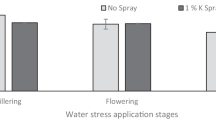Summary
The responses of dwarf wheat (Iriticum aestivum L.) to three levels of water stress at three growth stages, planting to jointing, jointing to flowering and flowering to maturity was studied under field conditions over two seasons at Hissar, India. At each of these stages, plants were subjected to three levels of water stress viz. −0.5, −1.0 and −1.5 MPa mid-day leaf water potential; during the remaining growth period, the plants were irrigated at 50% available soil moisture (ASM). Thus mild, moderate and severe stress treatments were compared with a no stress control (irrigation at 50% depletion of available soil water). A maximum grain yield of 5.20 tonnes ha−1 was recorded with no water stress treatment. All levels of water stress except −0.5 MPa during flowering to maturity reduced the grain yield significantly compared to the no stress treatment. The greatest effect of water stress on grain yield was observed during the planting to jointing stage. At this stage the highest reduction in grain yield (33.5%) was observed with −1.5 MPa plant water stress. Similar plant water stress during jointing to flowering and flowering to maturity reduced the grain yield by 26.0 and 22.6% respectively. During flowering to maturity, the effect of water stress on straw yield was not well marked. During planting to jointing and jointing to flowering stages, mild, moderate and severe water stress decreased the number of ear-bearing culms, where as number of grains per ear reduced with all water stress levels at all the stages except −0.5 MPa water stress during flowering to maturity. Maximum reduction in 1000-grain weight was observed with all stress levels imposed during flowering to maturity stage. Water-use efficiency was highest with no water stress (13.9 kg/ha mm) and lowest with −1.5 MPa plant water stress (11.2 kg/ha mm) imposed during planting to jointing stage. Results indicate that, the wheat crop should be irrigated at 50% depletion of available soil water (ASW).
Similar content being viewed by others
References
Aspinall D, Nicholls PB, May LH (1964) The effect of soil moisture stress on the growth of barley. I Vegetative development and grain yield. Aust J Agric Res 15:729
Begg JE, Turner NC (1976) Crop water deficits. Adv Agron 28:161
Choudhury PN, Kumar V (1980) The sensitivity of growth and yield of dwarf wheat to water stress at three growth stages. Irrig Sci 1:223
Dastane NG (1967) A practical manual for water use research. Nav Bharat Prakashans Deccan Gymkhana Poona 4:98
Day AD, Instap S (1970) Some effects of soil moisture stress on the growth of wheat. Agron J 62:27
Fischer RA, Lindt JH, Glove A (1977) Irrigation of dwarf wheats in the Yaqui Valley of Mexico. Exp Agric 13:353
Johnson RR, Moss DN (1976) Effect of water stress on 14 CO2 fixation and translocation in wheat during grain filling. Crop Sci 16:697
Kramer PJ (1963) Water stress and plant growth. Agron J 55:31
Robins JS, Domingo CE (1962) Moisture and nitrogen effects on irrigated spring wheat. Agron J 54:135
Scholander PF, Hammel HT, Bradstreet ED, Hemmingsen EA (1965) Sap pressure in vascular plants. Science 148:339
Sinclair TR, Bingham GE, Lemon ER, Allen LH Jr (1975) Water-use efficiency of field grown maize during moisture stress. Plant Physiol 56:245
Singh KP, Kumar V (1979) Influence of irrigation on the leaf water potential and yield of wheat and barley at two dates of sowing. Field Crops Res 2:117
Singh K, Narang RS (1971) Influence of timing of first irrigation on the performance of high yielding wheat strains and their water use pattern. Indian J Agron 16:366
Singh M, Singh K, Singh TN (1977) Effect of time of first irrigation on yield and uptake of nitrogen in dwarf wheat varieties. Indian J Agron 22:17
Virmani SM (1971) Rooting pattern of dwarf wheat. Indian J Agron 16:33
Author information
Authors and Affiliations
Rights and permissions
About this article
Cite this article
Singh, T., Malik, D.S. Effect of water stress at three growth stages on the yield and water-use efficiency of dwarf wheat. Irrig Sci 4, 239–245 (1983). https://doi.org/10.1007/BF00389646
Received:
Issue Date:
DOI: https://doi.org/10.1007/BF00389646




